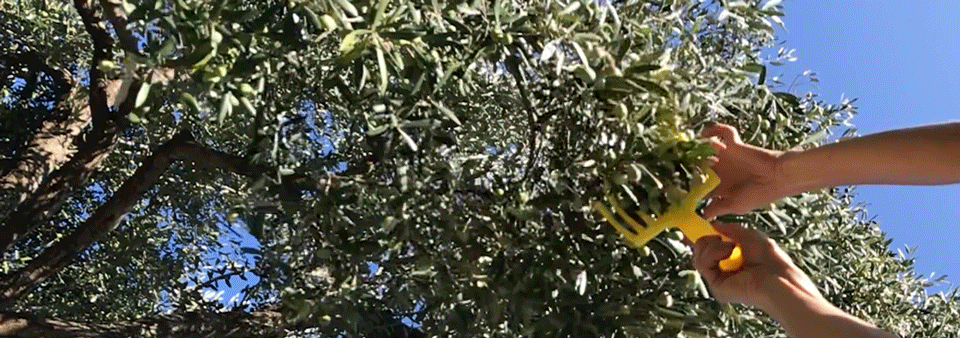
Five reasons why I love Autumn in Tuscany
I’m not going to even count the fact that I love orange, because that’s an all-year basic for me.
Going out on a limb I’m going to say that Italy is at her very best in the Fall. Temperatures are perfect—crisp at night but warm in the day, the light is gorgeous—those long slanting beams of sun across the landscape, and most of the tourists have left allowing cities and villages to draw a deep breath.
If that’s not enough, here are a few more reasons to love Italy in the autumn.
The olives are ripe
Every year I turn into a farmer, not something that past Nancy would have imagined on the list of possibilities for future Nancy. I scrutinize weather predictions. John and I walk the orchard to see how far along the olives are in ripeness. I scheme about who I can invite to visit and rope in to help, and beyond that how many additional pairs of hands we’ll need. I call the olive press to see when they open for the season and book our time on press. That appointment starts the picking clock—not good to allow olives to sit any more than 48 hours between when they are picked and pressed.
The decision of when to pick has an impact on the oil. Early and it’s wonderfully peppery and filled with polyphenols, which are rumored to be very good for you and also help the oil last longer. Let them sit on the tree for longer and the quantity of oil increases and the oil is more mellow. We pick as early as we can as we love the intense taste. In case you are curious about what an olive press is like (this one includes wine, grappa, freshly baked cookies, and loads of dogs) here’s an earlier Itch.
This year is in the can, so to speak, and was a good one. Despite record-breaking heat in July, an epic drought in August, a hail storm in September that knocked off about a third of the olives, and an unusually aggressive pruning we did in the Spring where we took off about 2/3 of the main trunks of many trees, the unphased olives trees did their thing and gave us slightly over 500kg. of olives, resulting in about 65 liters of oil. Thank you trees.
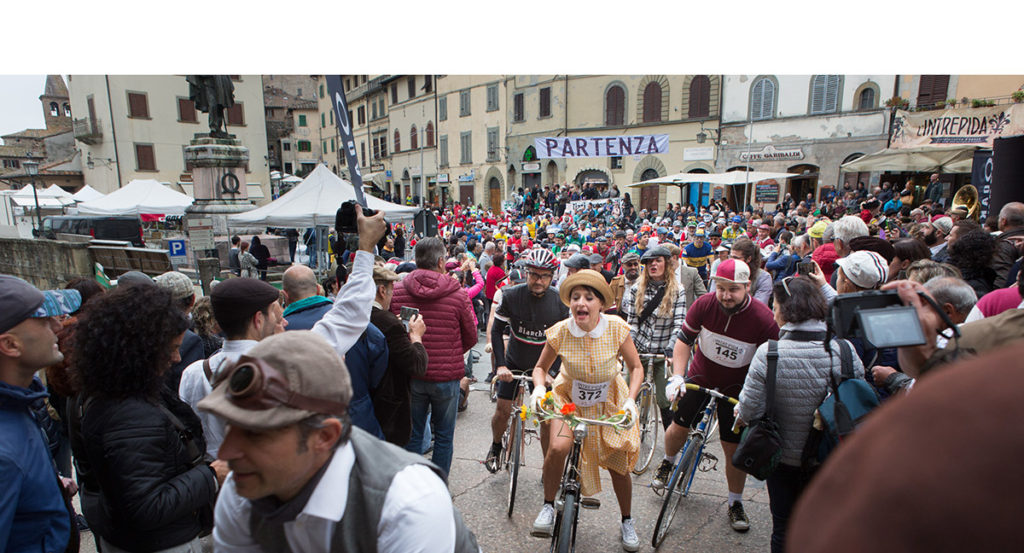
L’Intrepida, the vintage bicycle race
One of the most wondrous things our village does, out of many, is L’Intrepida, which, just to be clear, means “The Intrepid”. This year over 900 riders assembled from all over, including a friend of ours from California, to ride either a 42, 85 or 120 kilometer trip through the Tuscan countryside. As charming as this thing sounds, it is not for the faint of heart. All bicycles need to be pre-1987. Hasn’t it been since then that they’ve developed all those good gears and tires that make you actually able to climb mountains on dirt roads? That doesn’t stop this gang. Not only do their bikes look uncomfortable, many are also cycling in vintage wool pants and shirts. Luckily they are well fortified by rest stops at castles with wine, vin santo (a local dessert wine) and pastries. Water is not on offer. Apparently there is a hell of a lot of hydration in red wine.
My friend from California had mistranslated the registration form and hadn’t come prepared with a doctor’s report clearing him to participate. The ever-practical Tuscans quickly came up with a solution. He could ride, unofficially, then when he got to the finish and was clearly still alive he could claim his number along with his goody bag. Sadly, upon arriving at the finish he wasn’t given his original number, “123” but did get the locally-sourced goods: a big bag of packaged pre-toasted bread slices, a bag of coffee, a package of feminine douche products, some pasta, and an herbal antibacterial nasal spray and throat wash. Now wasn’t that worth a bunch of kilometers on a gravel road, uphill, on a bike with lousy brakes, wearing wool? Apparently, it is.
What it is really like to ride in the L’Intrepida.
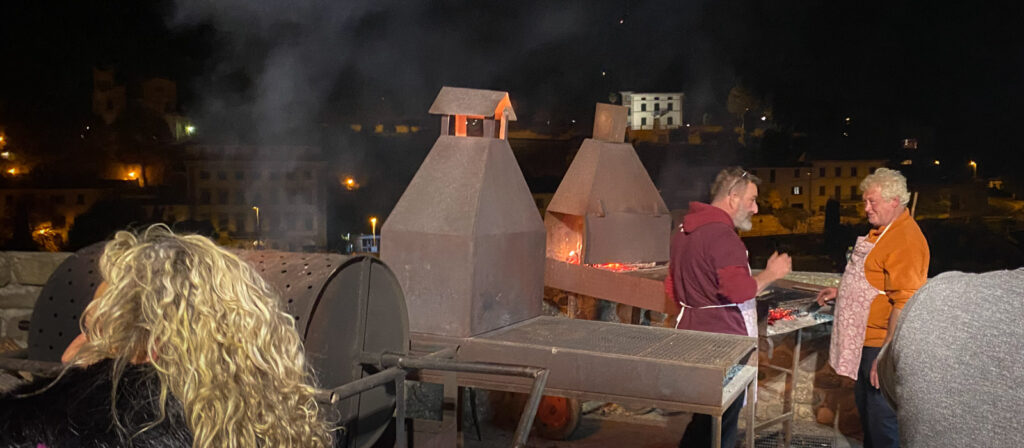
The food festivals
Step back fifty years, complete with a local band playing music from the roaring 1970s over distorted speakers that date back even further. Join the queue to choose and pay for your meal in advance from the volunteers lit by glaring overhead fluorescent lights. In an adjoining tent you’ll find a line up of cooking stations, usually involving large open fires and sometimes cauldrons of polenta, manned by local cooks and volunteers. Go into a large tent and sit down at endless banquet tables, all covered with the latest in plastic tablecloths, hand over the ticket you received when you paid, and you will be rewarded with the local speciality in small plastic bowls, often with plastic sforks. Welcome to the world of the sagra, or village festival.

They mostly take place in the fall, and almost every village has one dedicated to its own speciality food. Just up the hill from us is the sagra of a special kind of chestnuts, called marrone. A nearby village in the other direction celebrates polenta. A tiny hamlet in between has a festival dedicated to ciaccia, the local deep fried bread. Slightly further away you’ll be able to find sagras focused on truffles, or porcini.
Our village’s festival celebrates a really fat spaghetti noodle, called bringoli. You’ve got two choices: meat sauce or mushroom. Next to the pasta cooking stations are these really wonderful grills they have here with roaring fires in an upright chamber in the back and a long flat tray in front in which the hot coals are spread, perfect for grilling sausages and pieces of bread that are then rubbed with garlic and drizzled with just-pressed olive oil. Prior Itch: In praise of fat spaghetti. (I do love this post.)
Although popular with the few tourists who are here at this time of year, it’s mainly locals who attend and a time to catch up, see old friends, and for kids and teens to run loose in packs with their own codes and rules. All is accompanied by young wine, almost undrinkable. Usually a euro for a plastic glass and about four for a bottle.
I adore the purity of these events. There’s no hushed-voice, precious attitude that I sometimes found in the Bay Area around food. This is just what’s always been eaten and celebrated, a justification for pleasure and joy, but not for self-gratification or congratulation. And there are absolutely no long descriptions of the provenance of very element. People just know where it all comes from by who brought it to the festival and who is cooking, which is deeply lovely. Give me a plastic sfork every time.
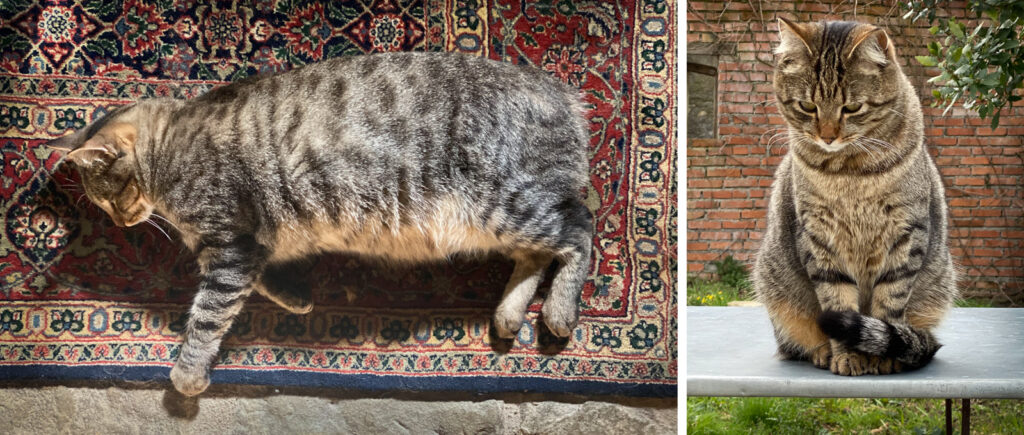
Melvin gets his winter body
Melvin was born in the woodshed, the product of a fly-by-night father and an indifferent mother. She had clearly had too many children before and did the bare minimum to keep the babies alive, visiting only long enough to feed them. Dad was just out for a good time and never showed his face when it came time to raise the kids.
John found Melvin and his siblings one night while getting wood for the fire and we put Donella, who is our resident feral cat tamer, on the case. I have learned that every locality, from Berkeley to the Upper Tiber Valley has a Feral Cat Woman. You figure out who she is and she will always have a feral cat trap you can borrow to catch the kittens so you can bring them into a small enclosed space (like a bathroom) and start the process of taming them. (As you can tell, we have some experience in this having been “blessed” on three occasions with feral kittens in or around our homes.) We got three of the four siblings adopted but ended up with Melvin.
Melvin lives life on his own terms. He never lets you forget that he is, in his heart, still wild and untamed. But he follows you around the yard when you work, usually directly under foot or in the tree you are working on, demanding snuggles. Indoors he is much more aloof, at least until Sebastian “broke” him this summer and now he will sometimes be cuddled even inside, as deeply conflicted as this makes him.
We see Melvin’s relatives everywhere. There’s the old Melvin, clearly the survivor of many fights, whose body moves like a wooden block—no feline undulation here—who could be dad or granddad. There are teenage Melvins swaggering around. We see mom occasionally, usually escaping from where she has hidden another litter. (Don’t get me started on how spaying and neutering is less common in Italy.)
But all the male cats, not just in Melvin’s family but across the valley, share an extraordinary trait. The Winter Body. Male cats gain significant amounts of weight in the winter and are thin in the summer. The first time we went through this with Melvin I thought there was something wrong and was ready to take him to the vet when I started noticing that the same thing was happening to all the male cats around us. It’s extraordinary to see this skinny cat suddenly add another half-cat or more to his body mass. November is a prime month for beefing (or catting?) up and we are suddenly filling the dog food and cat food bowls several times a day. (Melvin often eats Lola’s dog food as he believes that she is actually his mother.)
Maybe we should all embrace the Winter Body. It would make the season much more fun.
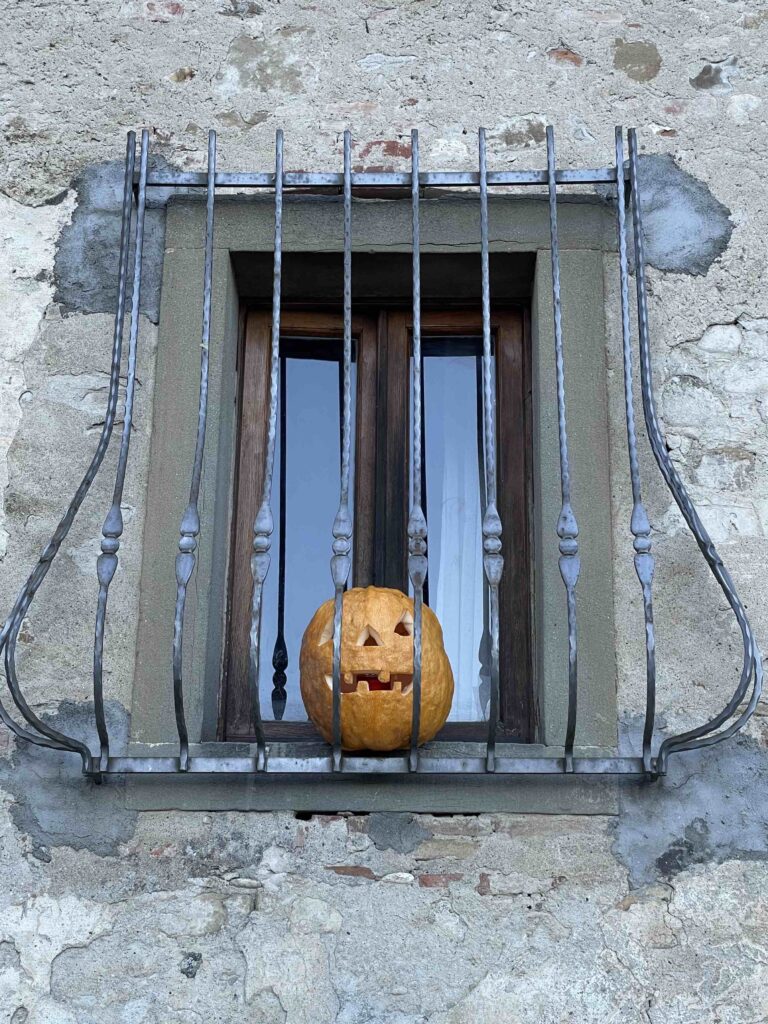
Halloween
The big event in Italy is not Halloween, but All Saints Day on November 1st, which is a national holiday. The roads around the cemetery are packed as people come to clean and decorate the graves of their loved ones with fresh plastic flowers and battery-operated candles. (For more about how Italians celebrate All Saints, or the Day of the Dead.)
When we first moved ten years ago I was feeling guilty that the kids wouldn’t have a proper Halloween. Sebastian and I tried—he dressed in costume, I put on a hat and carried all his Nerf guns, and we went out trick or treating in the piazza to the local merchants who reacted with confusion and tried their best. Sebastian scored a sausage from the butcher. A friend had brought us bags of Halloween candy so I handed it out to people we saw in a sort of reverse Halloween tradition.
Things have changed in ten years. Now Halloween is becoming very popular—it gains momentum every year. Now our village was packed with kids in costume. It’s the most profitable evening of the year for the big disco twenty minutes away. Trick or treat is still going from store to store rather than house to house, which is lucky for us as they don’t yet sell packages of small candies for this purpose.
But what really stopped me in my tracks was the a local grandmother in our hamlet who drives a Lada 4×4 and is about as far from trends as anyone I can imagine put a lit, carved pumpkin in her window, behind her protective metalwork. This was Halloween breaking through in an unprecedented way. When I saw her a day or so later I complimented her on her pumpkin and she beamed. Did you notice that it was smiling, she asked.






No Comments